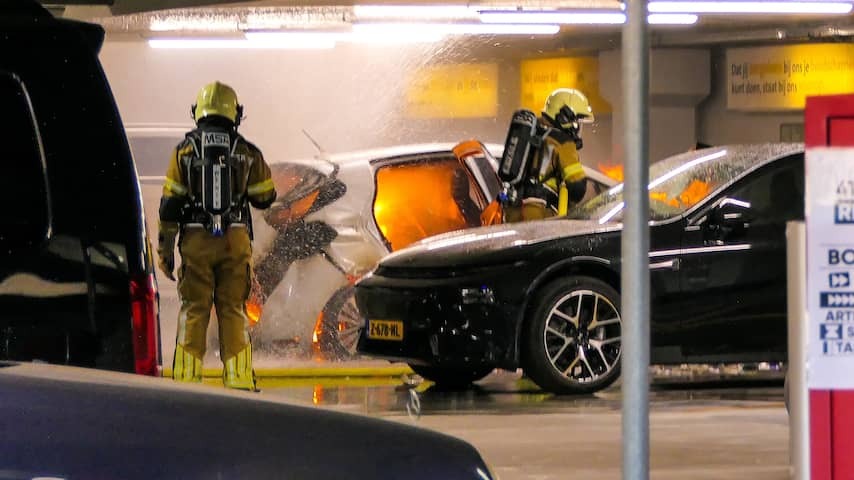
Dutch people are embracing electric driving, but the fire department has much more difficulty extinguishing plug-in cars. This was recently evident again in several car fires. Extinguishing an electric car is time-consuming and risky. Unfortunately, a real solution for the fire department does not yet exist.
It happens regularly: an electric car that catches fire and causes chaos. For example, in April, a supermarket in Enschede had to be evacuated because an electric vehicle (EV) burned out in the parking garage.
In June, the cargo ship Morning Midas had bad luck on the Pacific Ocean. A fire broke out in the storage place for almost eight hundred electric and hybrid cars. The crew could not extinguish the fire and had to leave the ship. It was reminiscent of the burning ship with electric cars above the Wadden Islands, two years ago.
How do you extinguish an electric car in the world? The fire department does not yet have the perfect solution for that. It is necessary, because more than a million Dutch people already drive an electric vehicle. And they are also becoming more affordable.
Because there are more EVs driving around in the Netherlands, the number of incidents with an electric car is also increasing. In 2024, it was 10 percent higher than a year earlier, according to figures from the Dutch Institute for Public Safety (NIPV). In 221 of the 356 cases, the vehicle caught fire and in a quarter the battery. A battery pack that spontaneously catches fire is rare, the NIPV emphasizes. More often, a car fire is caused by defective wiring or arson. The fire department still has more difficulty extinguishing it.
Extinguishing EVs is difficult because the battery pack is deep in the car floor. Such a package consists of many small, tightly packed battery cells. If one catches fire, a chain reaction can occur in which other cells ignite. The car continues to burn or can even catch fire again and again hours later. The vapors from the battery cells are also toxic and highly flammable, creating a risk of explosion.
Electric truck does not fit in a plunge pool
The immersion container is a way to thoroughly extinguish EV. Salvagers then lift the car into a container and place it underwater at a safe location.
“A salvage company once came up with this method by lifting a smoldering plug-in car into the ditch,” says Esther Lieben of Brandweer Nederland and the national task force Safe Energy Transition. “The immersion container is still the most used extinguishing method for a battery fire in our country.”
The Dutch government wants all road traffic to be emission-free from 2050. Freight transport must also be plugged in, which means that all new trucks from 2040 will be electric. They absolutely do not fit in an immersion container.
The NIPV is currently investigating solutions for e-trucks. It has already introduced a new extinguishing method for electric cars, which has been used by corps in The Hague, Rotterdam and Utrecht, among others, since this year.
Fire hose drills a hole in the battery pack
The system is called UHD (ultra-high pressure), says Tom Hessels, NIPV advisor for energy and transport safety. “The jet contains metal particles and is so concentrated that it can spray through a wall.”
The UHD system drills a hole in the battery pack and then submerges the battery cells with extinguishing water. Sounds good, but Lieben is critical. “Hold your hand in front of the jet and you’ll have a hole in it. So we are careful with the use of the system.”
Each UHD team consists of six to eight people, to control the sprayer and make the area around the burning plug-in car safe. The firefighters undergo special training for the system.
“It costs a lot of time and money,” says Lieben. “Personally, I would therefore only let the well-trained specialists deal with UHD. It is less suitable for fire volunteers, they have too little time for training and maintenance of this specialty.”
‘Plug-in cars are better banned in underground garages’
Letting electric cars burn out is not an option in, for example, a residential area or a parking garage. Lieben would prefer a national ban on plug-in cars in underground garages, so that fires such as the one in Enschede do not get out of hand. “I have seen a building go up in flames because a burning electric car five floors underground was inaccessible.”
Lieben thinks that safety will already be improved if EVs and charging stations are only allowed at the entrance of a parking garage. “Unfortunately, our safety team is often invited too late to a construction project to advise on the design plans. Sometimes we are even laughed at a bit.”
In the Netherlands and the rest of the EU, no new fuel cars may be sold from 2035. The number of plug-in cars is expected to increase more and more rapidly in the coming years.